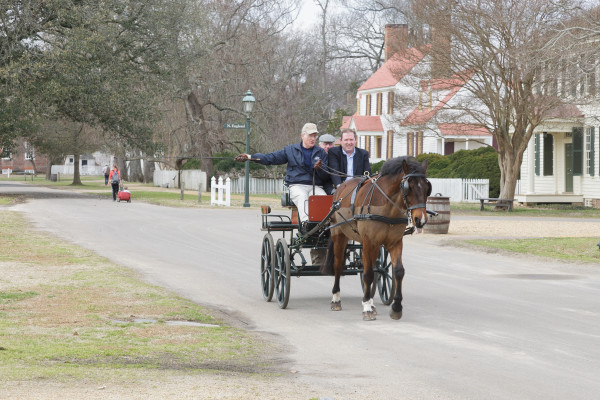
I’ve got a 15-year old son who will be driving soon, so when I had the opportunity to see how Colonial Williamsburg was training coach drivers, I jumped at the chance.
Steve Holm, who has been working with horses and driving coaches for half a century, was in town to evaluate the driving skills of ten Colonial Williamsburg coach drivers. Unsurprisingly, they all easily hit their marks.
So if our drivers are so good—and they are—then why even bother?
Paul Bennett, director of the Coach & Livestock Program, explained that the training was part of a strategic plan to empower and train staff. By passing the course, they earn an internationally-recognized certificate that documents their skill level. Sure, they work for Colonial Williamsburg, but what precisely does that mean? The certificate makes it easier for the drivers to prove they are world-class drivers.
It also offers reassurance to our guests that they are completely safe when they visit. Not just anyone can drive a coach.
The program is administered through the Carriage Association of America (CAA), a 3,000-member organization dedicated to the preservation and study of horse-drawn vehicles. It is an Americanized version of a program developed by the British Driving Society. The CAA brought it stateside about ten years ago.
I tagged along as Steve did his evaluation of Bob Couperthwaite, who started as a storyteller at Colonial Williamsburg and even served as the colonial auctioneer for a time. He’s been driving coaches for about five years.
Like all the drivers, Bob received a reading list and syllabus a couple of months ahead of his exam and “road test.”
The syllabus is like a Driver’s Ed manual, with checklists of all the knowledge and skills that the driver needs to know to pass the test. It’s primarily an oral exam, with Steve asking selected questions to gauge the student’s understanding of the coursework. If he senses uncertainty, he can probe a little deeper wherever he feels it might be necessary.

Safety is the biggest priority, and it starts long before getting behind the reins.
Bob had to show that he was skilled in caring for the horses, harness, and the coach.
With the horse, he has to know how to groom it, attend to its feeding and stabling, and look after its health. Are its shoes worn? Can you recognize an illness?
The driver also has to know the condition of the vehicle and how to look for problems. You can’t wait for the check engine light here. And the harnesses have to be treated properly.
Once all that is squared away, it’s on to the Practical Driving portion of the test.
Bob harnessed Gunner as Steve observed. He kept up a steady stream of chatter, explaining all his actions so Steve could know that he understood how and why each step was performed.
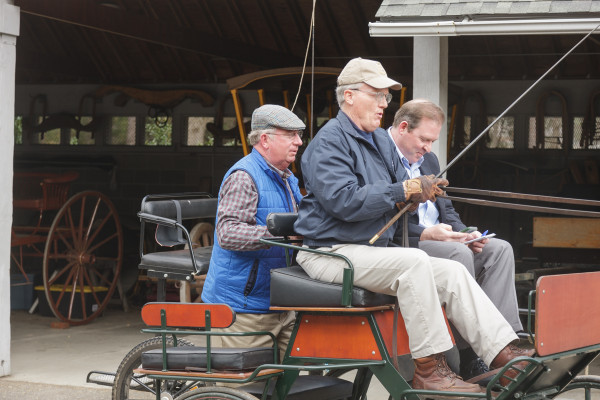
Bob’s horses are Chief and Toby, so this offered the extra challenge of working with unfamiliar horses, a step typically reserved for advanced training. “You don’t know if he’s lazy or if he’s more ambitious,” said Steve. “There are a lot more unknowns. It isn’t something you can really prepare for.”
But Bob handled Gunner masterfully. I know this because Steve said so. Bob humbly gave the horse most of the credit. (“This is a wonderful little horse,” he says partway through our ride.)
After the harness was set, Bob attached the carriage. With three of us on board, Gunner, about 1100 pounds, would be pulling nearly his own weight.
Time to board.
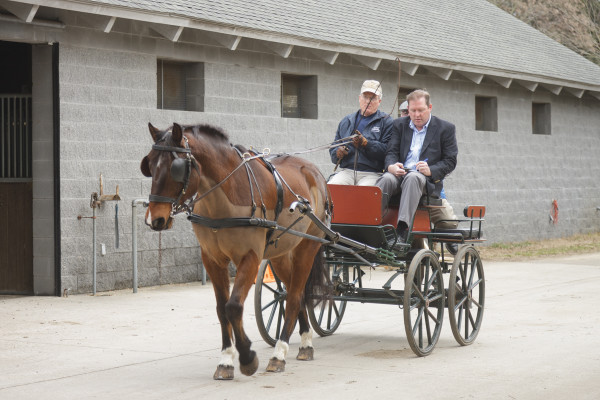
I was just trying to stay out of the way, but Steve had me sit in the front seat next to Bob while he stood in back. It was… a little tight as I leaned to the left to avoid impeding Bob’s left arm.
We set out from the Coach and Livestock building. “It’s just like driving your car,” says Bob as he anticipates the unexpected. He watches for a car backing up, or a golf cart, or a stray wheelbarrow as we head through an employee parking lot and into the Historic Area. The original defensive driving.
Bob gently suggests that by putting my feet on the footboard I might not go flying if they hit an unexpected bump.
We turn right onto Nicholson St. “Gunner, pick it up!” Bob brings Gunner into a nice trot on the quiet back street, then uses the reins to induce a half-halt, a gradual slowing as we start to pick up speed down a hill.
Bob is comfortably in command as we turn left on Queen St. “See how the horse carries himself to the right? I need him to go straight so I just give him a subtle little tug to set him straight.”

Bob explains that there are three ways to communicate with Gunner: with the reins, with the whip, and with his voice.
I learn that the whip isn’t to punish the horse, but to give the horse a gentle tap to let him know when and where to turn. It’s an extension of the driver’s arm, which is also used to signal turns. Bob held it at a 45-degree angle, explaining that he holds it relatively upright because of the tendency of guests to come close to the carriage even when it’s in motion. Wouldn’t want to poke someone’s eye out.
We take another right to head west on Duke of Gloucester St. People smile and wave. Bob says he considers himself an ambassador, but maybe there’s a little rock star there too.
When we get to the circle in front of the Governor’s Palace, Steve has Bob go around one in each direction. The couple who are walking nearby seem slightly startled when we reverse course to head back in their direction.
Sometime in the next year Steve will return to evaluate the drivers on more advanced skills, which include working with unknown horses and more complicated driving maneuvers, such as driving in a serpentine pattern and a true circle. “The next level is a huge step up,” says Paul, so there will be lots of training over the course of the year.
Down the road, every new Colonial Williamsburg coach driver will be required to pass both levels before they are permitted to take guests on tours through town.
Bob will be ready for it. Until then, think about taking a carriage ride. You’ll be in good hands. And if you find yourself sitting behind Coachman Bob, he promises to tailor it to whatever your interest might be.
UPDATE
The coach drivers received certificates for passing their tests on March 9. Congratulations to all of them!

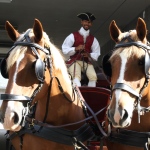
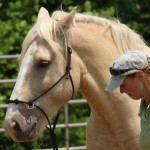

Some years ago I was on the Palace Green watching a coach with guests on board drive across the Green when suddenly the right rear axel broke off. It was a quick stop then! The crew from the Wheelright shop came and soon several other employees. The thing that I really remember was the wheelright guys pointing to the broken axel and repeatly telling everyone that it was “an outside contractor!!!” Since no one was hurt it was pretty funny.
That’s a great story. I asked John Boag, Master of the Wheelwright Shop, what he remembered of the incident. Here’s what he said: “. The incident was years ago, I have a few photos of it. The red sociable had just had new axles installed and was just in front of the Wythe house when the axle arm broke. The axle, being all metal was made by an outside contractor, but I don’t recall anyone saying that. We all were a bit stunned and glad no one was hurt! I’m the only one at the wheelwright on staff that’s been around long enough to remember that day.”
Thanks Bill !!